Sphingidae: Philampelini:
Eumorpha of Suriname
Eumorpha megaeacus, Albina, Marowijne District, Suriname
July 20, 2011, courtesy of Johan van't Bosch.
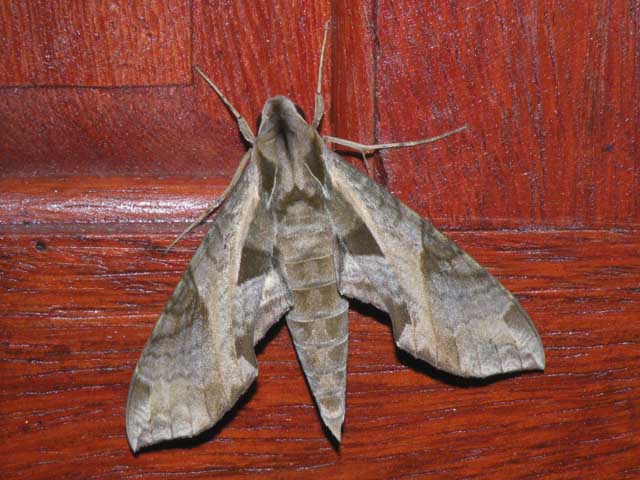
Eumorpha megaeacus, Albina, Marowijne District, Suriname
July 20, 2011, courtesy of Johan van't Bosch.
Many thanks to Johan van't Bosch who has granted permission to post his images of live Sphingidae from Suriname. In July 2011, Johan has photographed many species, including Eumorpha capronnieri and Eumorpha megaeacus in eastern Suriname.
 |
Philampelini
 |
Eumorpha fasciatus, the Banded Sphinx |
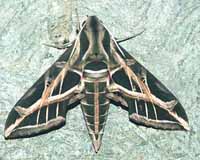 | Eumorpha vitis the Vine Sphinx: Forewing is generally quite similar to fasciatus, but note much longer internal extension of the lowest thin beige post median line into the median area. In fasciatus, this lower thin line in the median area is only a very short dash before meeting the broad transverse lines. Vitis lacks the broad pink band, found in fasciatus, along the hindwing outer margin. |
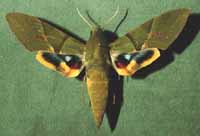 | Eumorpha labruscae the Gaudy Sphinx: Fw ground colour bright green to grey-green with a darker triangular median area, delineated by very dark am line and dark median line. There is a brownish blotch near midpoint of outer line of darker triangular area, followed by a beige blotch along the inner margin. |
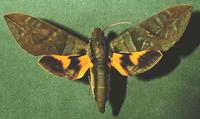 | Eumorpha phorbas: Fw ground colour grey-green with series of lighter grey-green bars, dashes, lines: aml runs straight from costa to i. m.; apical pml runs straight toward intersection of aml and i.m., but is broken at about 40% of its course by an L-shaped line that turns at about 135 degrees toward aml/im juncture. |
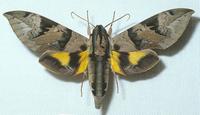 | Eumorpha capronnieri Fw ground colour grey to brown with distinct pattern of mottled green and darker brown areas. Forewing apex is slightly more produced and pointed in capronnieri, compared to phorbas. Note the outward extensions of dark green-brown stripes on abdominal tergites 5 and 6. |
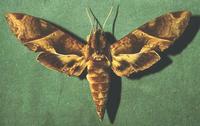 | Eumorpha anchemolus: Fw o. m. slightly crenulated. Similar to Eumorpha triangulum, but fw upperside pattern less contrasting and variegated. Dark subapical costal patch truncated on Rs4. White fringe along i. m. from body to slightly beyond median rhombiform patch very conspicuous. |
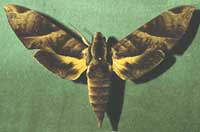 | Eumorpha obliquus: Fw: more glossy grey than anchemolus; three straight oblique parallel lines present in basal area running straight from costal margin to CuP fold; discal spot absent; dark patch near tornus broader than in similar species, rounded triangular; fringe of posterior margin buff, less extensive than anchemolus. |
 | Eumorpha megaeacus: Forewing has conspicuous, but ill-defined, pinkish-beige longitudinal band running mostly between CuA1 and CuA2 from wing base, subparallel to inner margin, to near outer margin. Below this band, to inner margin, appears a patchwork of patterns. |
 |
E. s. licaon v?? |
Sphingini: Manduca
Sphingini: Agrius, Amphimoea, Cocytius, Amphonyx, Morcocytius, Pseudococytius
Smerinthini: Adhemarius and Protambulyx
Dilophonotini: Aleuron, Enyo, Pachygonidia and Unzela
Dilophonotini: Aellopos, Eupyrrhoglossum, Nyceryx and Perigonia
Dilophonotini: Callionima, Erinnyis, Hemeroplanes, Isognathus, Madoryx, Oryba, Pachylia, Pachylioides, Phryxus
and Pseudosphinx
You are here: Philampelini: Eumorpha
Macroglossini: Hyles and Xylophanes
Go to Main Sphingidae Index
Go to Indices of Nations
Go to South American Index
Go to Central American Index
This page is brought to you by Bill Oehlke and the WLSS. Pages are on space rented from Bizland. If you would like to become a "Patron of the Sphingidae Site", contact Bill.
Please send sightings/images to Bill. I will do my best to respond to requests for identification help.
 Show appreciation for this site by clicking on flashing butterfly to the left. The link will take you to a page with links to many insect sites. |